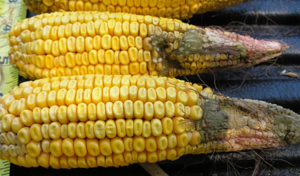
Aflatoxin: A new/old threat hits the upper Midwest
 By Dr. Dean Koehler
By Dr. Dean Koehler
Midwestern crop farmers and livestock producers are familiar with mycotoxins such as zearalenone, deoxynivalenol (also known as DON or vomitoxin), fumonisin and T-2 toxin. All of these toxins are produced by fusarium molds which are commonly found throughout the Corn Belt. In some years, they are present in up to 90 percent of all corn fields. Fusarium molds typically produce a cottony white-, gray- or salmon-colored mold growth.  In contrast, Midwesterners are less familiar with aspergillus molds, which produce aflatoxin. Aspergillus molds appear as a powdery (not cottony) olive green or gray-green growth that normally begins at the tip of the ear or at the site of an insect injury. (The photo above shows aspergillus mold on corn.) These molds are associated with very hot and dry conditions, which is why they are more common in more southerly climates. However, the drought and intense heat that occurred throughout the Midwest this summer produced conditions favorable for the growth of aspergillus molds. As a result, it is expected that this year’s Midwest crop will contain higher-than-normal levels of aflatoxin. Given the correct combination of temperature, moisture and time, aspergillus molds will produce aflatoxin, a toxin that is carcinogenic (cancer-causing) when ingested by animals and possibly humans. Corn containing aflatoxin can be rejected by grain elevators and ethanol plants in an effort to keep the toxin out of the food chain. The Food and Drug Administration has established the following maximum limits for aflatoxin:
In contrast, Midwesterners are less familiar with aspergillus molds, which produce aflatoxin. Aspergillus molds appear as a powdery (not cottony) olive green or gray-green growth that normally begins at the tip of the ear or at the site of an insect injury. (The photo above shows aspergillus mold on corn.) These molds are associated with very hot and dry conditions, which is why they are more common in more southerly climates. However, the drought and intense heat that occurred throughout the Midwest this summer produced conditions favorable for the growth of aspergillus molds. As a result, it is expected that this year’s Midwest crop will contain higher-than-normal levels of aflatoxin. Given the correct combination of temperature, moisture and time, aspergillus molds will produce aflatoxin, a toxin that is carcinogenic (cancer-causing) when ingested by animals and possibly humans. Corn containing aflatoxin can be rejected by grain elevators and ethanol plants in an effort to keep the toxin out of the food chain. The Food and Drug Administration has established the following maximum limits for aflatoxin:
- 200 ppb for finishing swine (100 pounds or heavier)
- 100 ppb for breeding swine
- 20 ppb for immature animals of any species
What should farmers do to respond to the threat of aflatoxin? First, scout corn fields and look for molds, including aspergillus. Mold growth and mycotoxin concentrations are not necessarily distributed uniformly within fields, so scouting should be widespread and should cover a large proportion of the total field. Fields with mold growth should be harvested first and quickly dried to stop any potential or additional toxin formation. Corn moisture levels of 13 percent or lower will inhibit additional mold growth. Keep in mind that the presence of mold doesn’t mean that mycotoxins are present. Nor does the visual absence of mold mean that no toxins are present. It is a good idea to submit representative samples for mycotoxin evaluation, especially if toxin-forming molds are observed during scouting. Your Vita Plus swine representative can help if you have questions about mold identification, mycotoxin testing or other concerns. About the author: Dr. Dean Koehler has served as swine technical services manager since joining Vita Plus in 2001. He was raised in southwest Minnesota and was active in 4-H and FFA. His youth livestock projects included raising and showing swine and sheep. Koehler earned his bachelor’s degree in animal science and his master’s degree and Ph.D. in swine nutrition from the University of Minnesota. His master’s research investigated the digestibility of raw soybean varieties naturally low in anti-nutritional factors when fed to growing pigs. His doctorate research utilized a stable isotope of the amino acid lysine to measure how efficiently sows transfer dietary lysine into their milk. Koehler is interested in all facets of swine nutrition. His role at Vita Plus is to provide technical service to the field and supervise the development of support tools, such as technical bulletins and spreadsheets. Additionally, he is the author the Vita Plus online grow-finish feed budgeting software, mentor.
| Category: |
Drought Feed quality and nutrition Mycotoxins Swine Performance |

